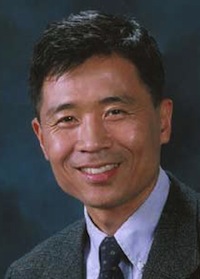With new high-tech materials, UW–Madison researchers aim to catalyze U.S. manufacturing future
Drawing on methods similar to those used to sequence the human genome, a multi-university team of researchers aims to discover and create revolutionary advanced materials that could help solve grand challenges in such areas as energy, national security and human health.

Eom
Led by Chang-Beom Eom, the Harvey D. Spangler Distinguished Professor of Materials Science and Engineering and Physics at the University of Wisconsin–Madison, the team has received $1.6 million from the National Science Foundation to fund its research. The grant is funded under the Designing Materials to Revolutionize and Engineer our Future program of the U.S. Materials Genome Initiative. The UW–Madison grant is the largest award under the initiative.
A major goal of the initiative is to boost U.S. manufacturing competitiveness and make the process of discovering and developing advanced materials faster, less expensive and more predictable.
The UW–Madison research is designed to yield multifunctional materials that advance the state of the art in lower-cost products ranging from everyday electronics and energy technologies to devices with capabilities that stretch the limits of human imagination.
“Industry is looking to overcome future limitations and to create new functionality,” says Eom. “What we envision is not just improving something, but actually developing properties that enable someone to create a device that works in a way that we haven’t yet envisioned.”
Eom is leading a team that will create a new material in the region — the interface — where two dissimilar complex oxide materials meet.
A mixture of metals and oxygen ions, complex oxide materials have wide-ranging electronic, optical and magnetic properties that make them more powerful alternatives to the conventional silicon-based semiconductors that form the foundation for cell phones, computers and other electronic devices. “You have that already complex structure and tremendous electrical, magnetic and optical properties, and when you put two complex oxides together to create an interface, that’s even more exciting and tremendous new materials can be created,” says Eom.
A major goal of the initiative is to boost U.S. manufacturing competitiveness and make the process of discovering and developing advanced materials faster, less expensive and more predictable.
Like DNA-encoded information determines how an organism develops, atoms are the building blocks that determine the structure and function of materials. Historically, researchers have created new materials based on intuition or on persistence, says Eom. However, his team, which includes UW–Madison Physics Professor Mark Rzchowski and theoretical and experimental materials experts from Cornell University, the University of Nebraska, Penn State University and the University of Michigan, will take an iterative approach.
The team will use massive computational power, guided by basic scientific principles, to identify and model ideal combinations from a virtually infinite menu of complex oxide materials.
From the ideal computer-generated models, Eom and his colleagues will create, or synthesize, the complex oxide structures with a high level of atomic precision. “Making structures perfect is very challenging,” he says. “But we have a demonstrated capability — a process to make almost atomically perfect structures. This is essential to the new phenomena we predict.”
As a result, the team will be able to replicate its model materials exactly. And where those two dissimilar complex oxides meet may be an exciting new material, a few atoms thick, just brimming with new properties that could enable a major technological advance.
The researchers will experimentally study the interface and, based on their findings, refine the theory and repeat the entire process until they find the “right” material with unique properties not currently available. “These new interfacial materials are some of the most promising in which to realize new phenomena that will challenge our current understanding, and that will develop new electronic device directions to address our society’s technology needs,” says Eom.
In addition to its research, the team also is planning several outreach initiatives that engage students and teachers from Puerto Rico and the United States in materials science and how atoms form a material and guide its properties.
Tags: engineering, manufacturing, materials science, physics, research


